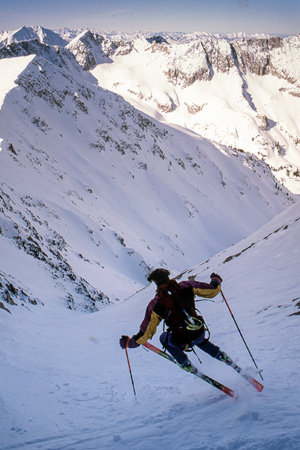The idea for The Chuting Gallery started in 1991 when a friend told me that, aside from Mt. Superior and Alta’s Main Baldy Chute, the Utah’s Wasatch Mountains didn’t have much steep skiing.
At the time, the backcountry bible for the area was the original Wasatch Tours by Alexis Kelner and David Hanscom, which heavily stressed avalanche safety and even pointed out all of the dangerous avalanche paths by denoting them with an encircled “A,” which coincidently is also the symbol for anarchy. It was almost like a hidden guidebook within a guidebook—just look for the “A” and go skiing there.

“Assuming you can find it (it took me two year), it’s a fun line with excellent visuals,” McLean pens of Benson & Hedges Couloir in The Chuting Gallery.[Photo] Jim Harris
At about the same time, I was visiting a friend who worked for the Utah Department of Transportation who showed me a three-ring binder of the more than 30 avalanche paths that threaten Little Cottonwood Canyon road and was complete with slope angles, total vertical and beautiful aerial photos of each line. Between this and Wasatch Tours’ lines of anarchy, there was a five-year list of things to ski.
Coming from a rock-climbing background, I was familiar with a climbing-guidebook format that included ratings and a checklist of all the climbs at the end of the book. Adding these into a steep-skiing guide made sense to me, but over the years they have created endless controversy, as many people don’t like the idea of rating backcountry runs and feel that a checklist just encourages people to somehow take more chances. Just after I completed the book, a very stern avalanche forecaster told me, “You are going to have the blood of a lot of innocent teenagers on your hands.” Fortunately, that hasn’t happened, which I think is due, in large part, to teenagers’ lack of interest in hiking uphill in deep snow for hours on end.

The late Alex Lowe takes flight onto the Pfeifferhorn’s Northwest Face. [Photo] Carl Skoog
My original concept for The Chuting Gallery was to make it simple enough that I could print it out on 8.5 x 11-inch paper, staple it together and give it to the 10 or so people whom I thought might be interested. I found influence from an irreverent guidebook on the Needles of South Dakota’s Black Hills that was written by “Dingus McGee & The Last Pioneer Woman” and also from an ice-climbing cult-classic by Charlie Fowler that was written in the same manner. Charlie’s book, all handwritten, contained lines like, “If you don’t like the names or ratings, write your own guidebook.”
There were never a set number of pages I hoped to write or number of runs I hoped to write about, and I’d find more lines to ski every time I went out. But at some point after five or so years it seemed like I’d gathered enough material for a book. The first two guidebook publishers to whom I showed it immediately said “no,” and since I had put in so much time and effort by then, I decided to publish the book myself.
What I didn’t realize was that my pages had by then far outgrown the limits of folding and stapling, so I had to use perfect binding, the method through which most paperbacks are manufactured. This was fine, I thought. Then I learned I had to print thousands of copies at a time to make the whole endeavor cost effective. Luckily, Salt Lake City has a huge printing industry, so a few weeks later, I was walking past newly printed stacks of the Book of Mormon and took delivery on two pallets of The Chuting Gallery. I was sure I would later find myself throwing most of them away.

Mike Quigley turns to page 61 on Bombay Chute in Wolverine Cirque. [Photo] Louis Arevalo
Selling things has never been my strong suit, but I started by going into outdoor retail shops where I’d usually get an order for two or three books. Then, once I’d returned home, there would be a phone message from the store saying they wanted another two or three because the employees had bought the first few. At the time, there weren’t many people skiing steep lines in the backcountry, so I was surprised when sales keep cruising along. As I later found out, a lot of people just like having a guidebook for reference, even if they have no intention of skiing anything in it. And, better yet, skiing guidebooks make excellent presents.
Aside from some grumbling about giving away secrets or writing a book about stupid, pointless lines that aren’t real skiing, the public reaction has been overwhelmingly positive. I’ve always liked the challenge of chute skiing and love seeing other people get turned on to it, as well.
In one of my favorite encounters, I was following a booter up Little Cottonwood Canyon’s Y-Couloir one day, and when I caught up with the group putting it in, they spontaneously started telling me about how their roommate had a copy of The Chuting Gallery and how thrilled they were to discover the backcountry through it. I’d never met them before, and I don’t think they knew I was the author, but to see how excited they were suddenly made the whole project worthwhile.










Related posts:
The Chuting Legacy: Andrew McLean's cult-classic guidebook turns 20
Ski Mountaineering Skills with Andrew McLean: Steep Skiing
Ski Mountaineering Skills with Andrew McLean: Ropes
The Transplant: Adam O’Keefe on The Chuting Gallery